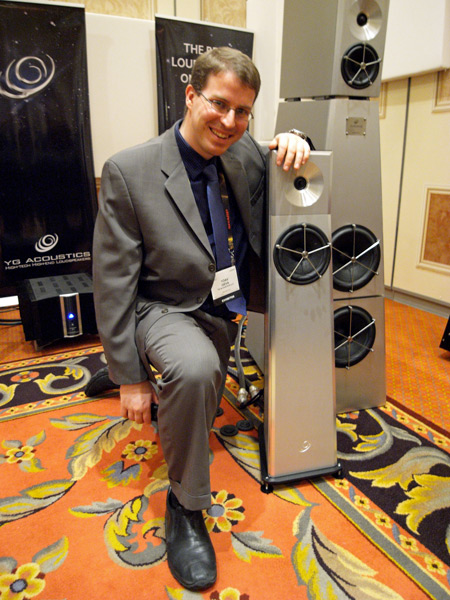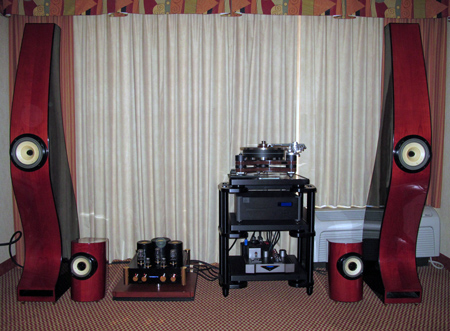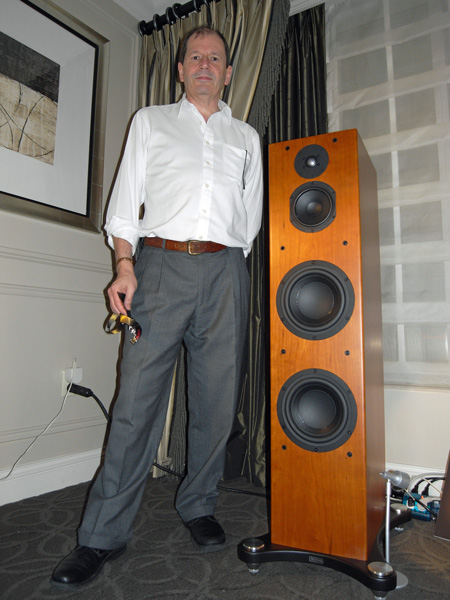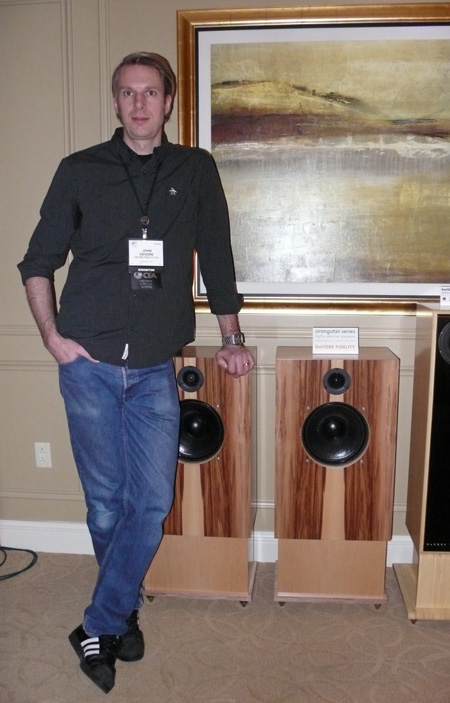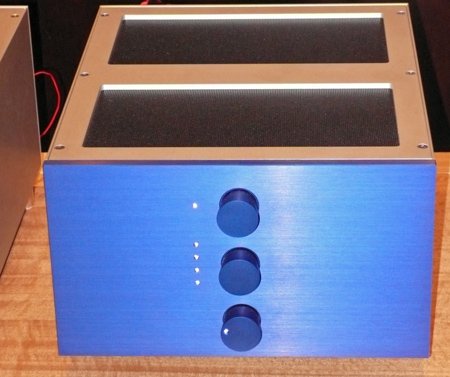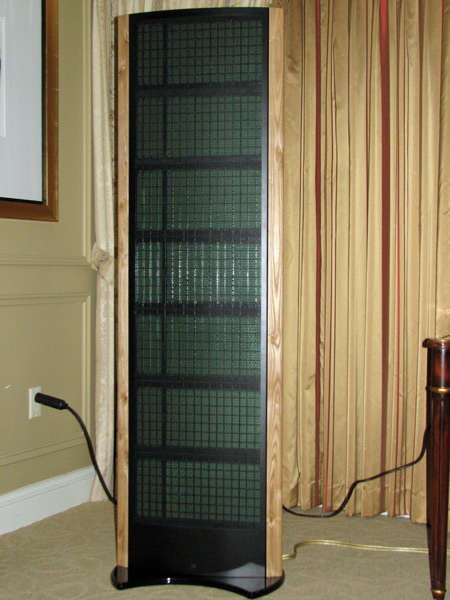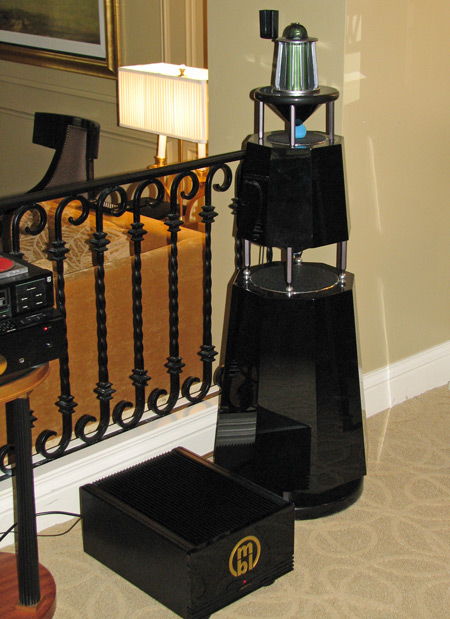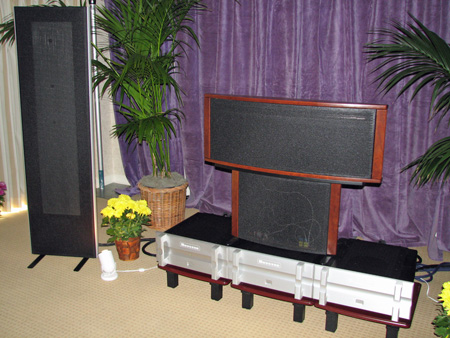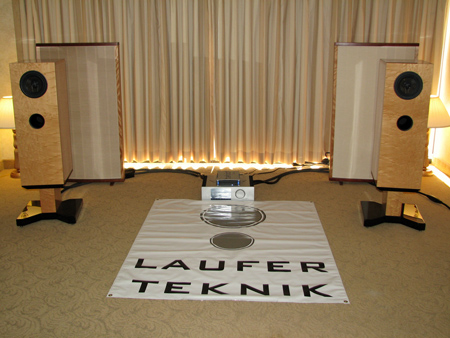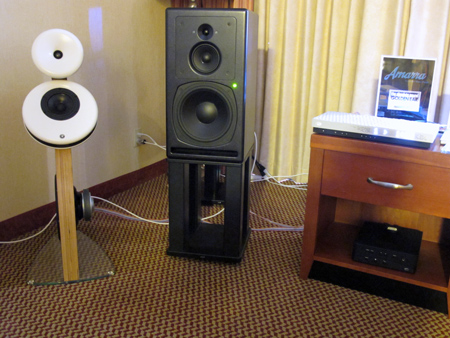LATEST ADDITIONS
Teresonic Speakers Play Loud
One of my last stops at THE Show at the Flamingo was the Teresonic room, where Mike Zivkovic demmed his 6'-tall single-driver Ingenium Silver Edition speaker using his own single-ended 2A3 tube amplifier. According to Mike, the amp uses interstage and output transformers from Lundahl and "there is not a capacitor in the circuit."
Epos Aims High With the Encore 50
Since the ES14 from the mid-1980s, speakers from the English Epos company have been renowned for their midrange magic, not for ultimate dynamics. But Mike Creek, Epos's owner, is aiming for both with the Encore 50, which made its debut at CES. This three-way floorstander, priced at $9995/pair, uses two port-loaded 9" woofers with Kevlar/carbon-fiber/pulp-composite cones, in a large cabinet to achieve a high 90dB sensitivity, while the metal-dome tweeter uses an injected-molded roll surround to give high excursion. The midrange is fed by a tapped autotransformer to allow adjustment to a tight tolerance in production.
John Devore and his Orangutans
I was highly impressed with the dynamics, speed, and pace of a new $8000/pair loudspeaker from John DeVore, a speaker maker from my area of the country, Brooklyn, New York. I had first read about John in the <I>New York Times</I> when it featured new and brave entrepreneurs making their way in Brooklyn during the recent recession. I was interested, because of my medical research background, that the very tall Mr. DeVore had been positively influenced in his younger years by an uncle who was a leading primatologist, and had take him to Africa to view various monkeys living in their natural habitat. As a result, John names his loudspeaker lines for various species, including the Gibbon, Silverback, and now Orangutan. This floorstanding, two-way, high-sensitivity ([95]dB/2.83V/m) loudspeaker features a 1" silk-dome tweeter and a reflex-loaded, 10" treated-paper woofer (rear port) in a cabinet with a lace walnut finish. I was struck by the similarity between John's energy and enthusiasm and the dynamics and pace of the music the Orangutan generated driven by the 15Wpc Mag Amp.
The Mag Amp—World’s First Switching Amp
John Devore was using this diminutive integrated amplifier, the German-manufactured Acoustic Plan Mag Amp, to drive his new high-sensitivity loudspeakers. According to Jonathan Halpern, the US importer, the Mag Amp uses a tubed voltage-gain stage and an output stage comprised of two small transformers with dual primaries. He described it as the "world's first switching integrated amplifier, and added that it was designed by Lars Lundahl in the 1960s. The 19 kg stereo chassis offers 15Wpc into 8 ohms and will cost $18,500. It played both a 1980s recording of Ella Fitzgerald and one of Stravinsky's <I>Pulcinella Suite</I> with great dynamics, speed, and detail. This is the kind of odd and fascinating gem one can uncover at the end of a day when one is too tired to rush out of an exhibit room, and instead collapses on the couch to listen.
King's Audio Prince II
One of the many delights of CES was running into Neil Sinclair, former owner of Theta Digital, in the hallways of the Venetian. In answer to my question, "What would you recommend I check out?" Neil led me to the King's Audio suite.
King's Audio King Tower
In the middle of the King's Audio room sat the omni-directional King Tower ($4500/pair). The speaker was created specifically because, according to the distributor, there was no affordable omni on the market. Paired with same substandard cabling as was the King's Audio Prince II electrostat, a $99 Philips CD player, and the mbl Noble series 4004 preamp and 8011 monoblocks, the speakers sounded quite promising. This is a speaker that needs a better source component and better cabling to fully demonstrate what it can do.
Magnepan—Updating a Legend
I finished my first day at THE Show, at the Flamingo hotel. (It's wonderful that CES and THE Show are now within easy walking distance.) Over the years, Magnepan has built some of the best-sounding speakers I've heard, and most often ones that perform at the level of speakers several times their price. The MG 1.6 is one of the High End's true classics and has always been one of its most spectacular bargains. One of Magnepan's demo systems was the brand-new MG 1.7. It's physically identical to the 1.6 but rather than planar-magnetic drivers for the bass and tweeter, the 1.7 use Magnepan's "Quasi-Ribbon." Both planar-magnetic and quasi-ribbon drivers are lightweight diaphragms onto which a conducting element is attached, but in the case of the planar-magnetic, the element is wire. In the quasi-ribbon, it's a very fine ribbon, or foil. The latter is lighter and covers more area, so the performance approaches that of a ribbon, where the conducting element<I>is</I> the diaphragm. The 1.7s sounded truly spectacular and at just $2000/pair, destined to be another winner for Magnepan.
Ascendo and Behold
In the Laufer-Teknik room, I had the opportunity to audition the Ascendo C8 loudspeaker ($9800/pair) with stand. This three-way includes a rear-firing ribbon tweeter and upward-firing, internal woofer, and has a specified sensitivity of 88dB
Gradient, Amarra, and more
On the fourth floor of THE Show, Tim Ryan of Simpli-Fi was demming the Gradient Helsinki 5.1 loudspeaker ($6500/pair, down from $8000 a year ago). This weird-looking loudspeaker produces anything but weird sound. Designed to avoid reflections from the sidewalls and floor, it has 85dB sensitivity, a nominal 6 ohm impedance, and a frequency range of 200Hz–20kHz.

